As we are coming closer to the end of 2018, let’s reflect on what has marked the year.
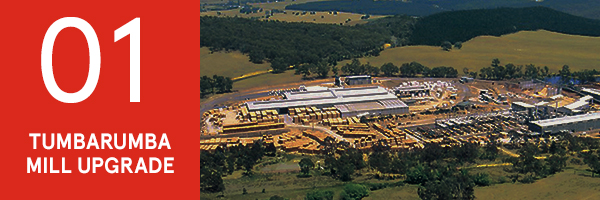
To ensure we meet timber demand volume and grade requirements, we acquired the most advanced Green Mill trimmer scanner system in the world.
The new trimmer scanner meets all the requirements for dynamic, fast-paced mill environments where speed, accuracy and durability are essential to achieve performance and recovery demands. The scanner enables us to make the right decisions at a very early stage so that we use the right fibre for the right products. When the log goes through the trimmer, we can quickly scan it for the best fibre and cut it for the most demanded grades.
This major engineering project and significant investment come as the market continues to experience high levels of demand for quality, Australian, treated pine framing, as key east residential building markets remain strong.
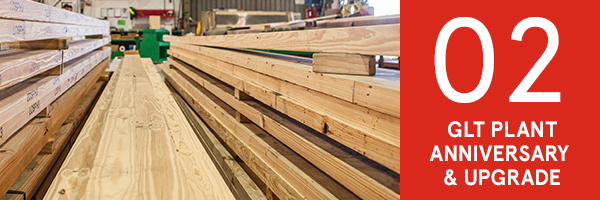
Our Glue Laminated Timber (GLT) Plant in Maryborough celebrated its 40th anniversary in August. A lot has changed since its opening in 1978, and during celebrations one of the most significant milestones in our history was announced: a major expansion to our GLT manufacturing capability.
Engineered timber manufactured from plantation softwood is an increasingly preferred building material for both commercial and residential construction projects due to its superior sustainability and environmental credentials.
We have been experiencing an increase in demand for GLT products. Our new capability will increase available volumes, improve our speed of delivery and broaden our product offer to capitalise on new growth opportunities for the timber industry.
GLT is the talk of the design and construction industry; with this investment, locally sourced, produced and certified Australian GLT products can be competitive in all project types.
The new state-of-the-art manufacturing plant will accompany the existing plant in Maryborough’s Industrial Estate. Construction has already started and is expected to be completed in Q3 2019.
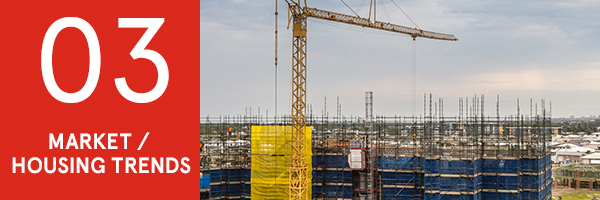
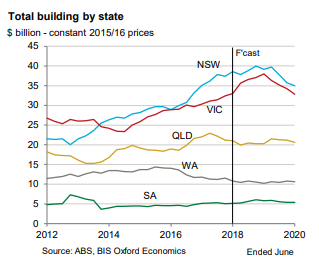
Building activity nation-wide has been mostly positive over the past five years, reaching an estimated $119.2 billion in 2017/18. This level is an all-time record, a staggering 21% higher than the previous peak in 2009/10.
New residential construction was the driving force over the 2013 - 2016 period, but now non-residential building is the key growth engine, which is estimated to have increased 14% in 2017/18.
Over recent years, New South Wales has witnessed a strong upturn in residential building activity, amassing an estimated financial year record peak of 74,417 commencements in 2016/17. However, from this record high, commencements are estimated to have decreased 9% in 2017/18. High density dwelling starts have fallen off the most, down 22% due largely to the slump in investor demand and apartment oversupplies appearing in some areas of Sydney.
Non-residential building has continued its upward trend in New South Wales, with activity expanding 4% in 2017/18. Economic conditions have improved in the state, supporting a broad lift across the building sub-sectors. Accommodation and entertainment building work has also grown. Sydney’s booming services sector has helped boost the business case for investment in new buildings, especially in offices.
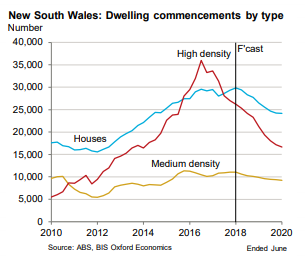
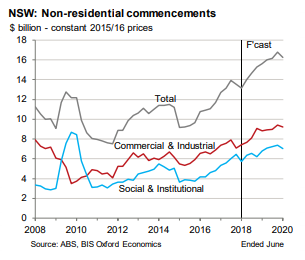
The Australian Capital Territory shows the strongest rate of population growth in Australia behind Victoria, with solid economic conditions driving strong residential building activity. With the latest approval data hitting a new record for high density dwellings, considerable improvement is forecast into 2018/19, with total commencements lifting 31%. Attached dwellings now completely dominate the dwelling mix in Canberra, set to represent over 70% of new home supply over coming years.
Non-residential starts surged to an estimated $1.38 billion in 2017/18 (+171%) with a series of new developments getting underway. The Canberra economy remains strong, with healthy population growth. With an allowance for additional major projects getting the go ahead, it is forecast that activity will rebound back to near $1 billion in 2019/20.

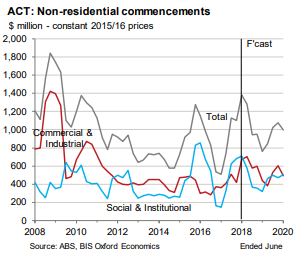
Victoria, with the nation’s strongest population growth rate, has contributed to a significant rise in the underlying demand for dwellings, supporting the high rate of residential construction over the last four years, especially in Melbourne. As at June 2018, Victoria had an estimated dwelling stock shortage of 16,400 homes. Despite the high level of supply set to continue, this deficiency only diminishes very slightly over the next two years. Victoria’s rate of population growth is set to remain strong, driving a continued high level of underlying housing demand.
A strong economic outlook and the state’s healthy budget position are helping drive non-residential activity in Victoria. From a relatively flat profile since 2010, non-residential building has shot up over the past two years, lifting 34% in 2016/17 and an estimated 39% in 2017/18 to a record $15.46 billion. The improvement has been broad, with all sub-sectors (except factory building) posting positive growth over this period. Despite a continuation of solid economic conditions, non-residential starts are forecast to normalise into 2018/19, but activity will still hold at a high base, above $12.5 billion.
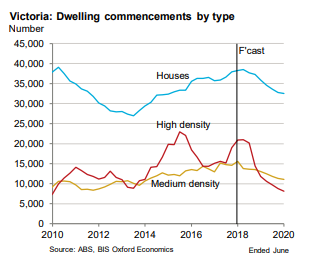

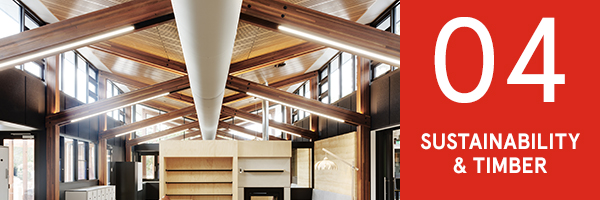
Historically, with all attention focused on building fast and inexpensively; little to no attention was given to the community and natural environment. However, as more people realise that sometimes overlooked behaviours can have an impact on climate change, sustainable, renewable and less energy intensive building materials will increasingly be preferred.
At Hyne Timber, we are proud to manufacture products from certified, sustainable, locally grown plantation softwood. It’s renewable, recyclable, waste efficient, biodegradable, non-toxic and it locks away carbon. Up to 50% of the dry weight of timber is carbon that the growing tree has removed from the atmosphere. Like any good farming practice, for each tree harvested, more than one tree is replanted so that the cycle can commence once again, generating more oxygen while removing more carbon and securing local Australian employment into the future.
Carbon emissions in the construction sector account for over 23% of total greenhouse gas emissions in Australia. Did you know that over 7.5 tonnes of carbon is removed from the atmosphere with each 12m3 house-lot of T2 Blue framing? The production, use and end-of-life processes associated with T2 Blue also uses much less energy than most other building materials.
We think it’s important to share the benefits of timber with the broader Australian consumer-base, so that they can make educated choices about the materials going into their home or investment.
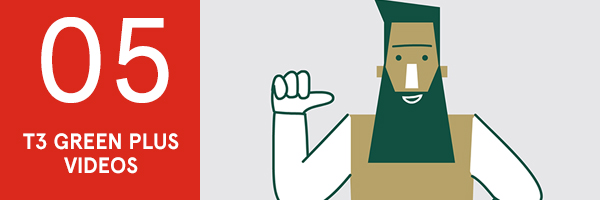
Earlier in the year, we had some fun creating a series of short videos about our all-new H3 treated framing product; T3 Green Plus.
While it’s outdoor living season, don’t hesitate to share these videos showing the benefits of our revolutionary new CodeMark certified treatment technology.
Watch these videos here.